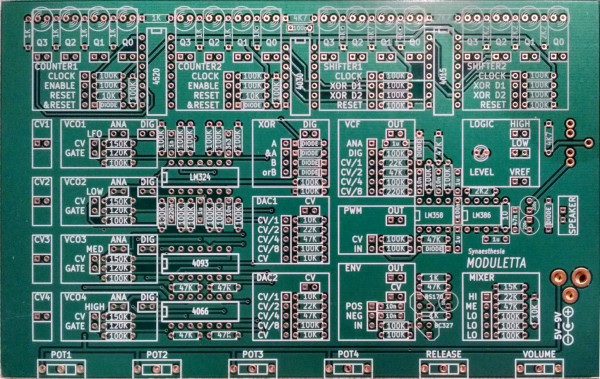
Moduletta
Designed by Klaus Rintdorff
I got to know Klaus Rindtorff and the Moduletta in June 2016 during my workshop "Labor Sound" (University of Art and Design Linz) as part of the Festival Zukunftsmusik. Klaus Rindtorff is a certified computer scientist with many patents and a hobby electronics designer and technician. His work focuses on digital and analogue sound generation and colored light sculptures. Of particular interest is the digital sound generation inspired by the circuits of Stanley Lunetta.
Soldering the Moduletta is not a matter of two hours. It is a modular synthesizer with many inputs and outputs, eight CMOS-chips, countless resistors and LEDs that need to be soldered. The Moduletta synth is a crossover between modular synthesizers and Lunetta circuits. Through plug-in connections, the analog and digital modules can be combined for sound generation. Included are voltage controlled oscillators, filters and PWM, as well as counters and shift registers for sound and rhythm. At the university workshop eight students started with the Moduletta and all worked fine. One student is performing live with her Moduletta.

Klaus Rindtorff (Linz - Zukunftsmusik 2016)
Interview with Klaus Rindtorff (January 2019)
Q: Klaus, when did you start designing autogenerative music machines and why?
Klaus: I guess it must have been the day when I discovered Lunettas on the electro-music.com forum. I always liked building circuits with digital logic elements, starting with TTL and later with CMOS chips. Lunettas use logic chips in a very creative way to generate sound. The fact that they are based on logic quickly leads to combining them with binary sequences to create patterns. The results are often surprising.
Q: How long lasted the process from the first ideas to the final concept and to the printed circuit board of Moduletta?
Klaus: I created many small Lunetta circuits in 2014 and 2015. Later I started mixing them with analog circuits using operational amplifiers as well. Early in 2016 I came up with the idea to combine them and create a small synthesizer that combines ideas from the Lunetta circuits with ideas from modular synthesizers, in particular the ability to create patches. It took me about three months to complete the design. That included a lot of experimentation to come up with a minimal, yet complete, set of modules to generate interesting sounds.
Q: Can you describe your Moduletta in some sentences.
Klaus: The Moduletta is a cross-over between analog circuits for modular synthesizers and Lunetta circuits. Most of the modules are implemented with logic chips. A few of them also create or accept analog control voltages instead logic levels. To create sound you connect the modules using patch cables, just like in a modular synth. The whole design is deliberately minimalistic and has a focus on providing as many possibilities as possible rather than generating high-fidelity audio.

Q: The Moduletta is a tribute to Stanley Lunetta, a musician who has developed countless circuits with CMOS chips and has influenced many musicians and designers. How strong had you been inspired by Stanley Lunetta?
Klaus: That influence is certainly very strong. I had built a few TTL based audio circuits a long time ago. Discovering the Lunetta circuits taught me many new tricks that are possible with only a few CMOS gates. The most fascinating circuits to me are those that generate small tunes from a handful of logic chips. Some produce just beautiful noise, some surprise you with even a bit of musicality in the patterns they produce. Have a look at the Chip-Tune circuits for example. You wouldn't expect a few chips to generate melodic tunes that run for minutes without repeating.
Q: The Moduletta is the most beautiful instrument I've ever
soldered myself? There is so much possible with it. Is the project complete for you or do you have any new ideas to further develop Moduletta?
Klaus: For now, the PCB boards are all gone and the project is at rest. However, I had a few ideas for additional circuits that could not fit on the board at that time. Plus a few new ones I came up with in between, like the combinatorial circuits to generate patterns, and oscillators that can be controlled by logic levels rather than control voltages to generate micro-tonal scales. Maybe even include a small micro-controller for some of the effects that otherwise would need a lot of hardware... And here we are again, the hardest part in the design is to limit yourself to the essential elements needed to achieve the goal you set for yourself. I would love to create a newer, bigger, version of the Moduletta that can contain them all, but first need to find the time for it.
Stanley Lunetta died March 3rd 2016.
Links:
Klaus Rindtorff - Moduletta Forum
Stanley Lunetta homepage
Sound Sculptures by Stanley Lunetta
Lunettas - Circuits inspired by Stanley Lunetta
Zukunftsmusik - Wolfgang >Fadi< Dorninger
Also published on Electronic Cottage